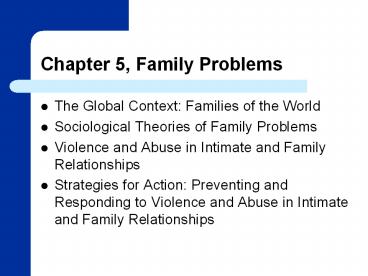Chapter 5, Family Problems - PowerPoint PPT Presentation
Title:
Chapter 5, Family Problems
Description:
Chapter 5, Family Problems The Global Context: Families of the World Sociological Theories of Family Problems Violence and Abuse in Intimate and Family Relationships – PowerPoint PPT presentation
Number of Views:189
Avg rating:3.0/5.0
Title: Chapter 5, Family Problems
1
Chapter 5, Family Problems
- The Global Context Families of the World
- Sociological Theories of Family Problems
- Violence and Abuse in Intimate and Family
Relationships - Strategies for Action Preventing and Responding
to Violence and Abuse in Intimate and Family
Relationships
2
Chapter 5, Family Problems
- Divorce
- Strategies for Action Responding to Problems of
Divorce - Nonmarital and Teenage Childbearing
- Strategies for Action Interventions in
Nonmarital and Teenage Childbearing
3
Traditional Model of the Family
- 1940 - 2/3 of U.S. families fit model of working
dad and stay at home mom. - 1999 - 2/3 of U.S. families with children under
18, were dual-earner marriages. - 1999 - less than 1/3 of U.S. families with
children under 18 had a working dad and a
stay-at-home mom.
4
Single-parent Families
- One in 10 U.S. households consist of a single
parent with children under 18. - The percentage of U.S. children living with one
parent increased from 20 in 1980 to 27 in 1999.
5
Divorce and Remarriage
- About half of marriages are expected to end in
divorce. - More than half of persons who divorce get
remarried. - 1/3 of children will live in a remarried or
cohabiting household before they reach adulthood.
6
Tradition of Marriage
- Most people who cohabit marry, although not
necessarily the person they cohabited with. - Less than 4 of Americans over 65 have never
married.
7
Structural-Functionalist Perspective
- Family performs functions that help society
- Replenishes population.
- Socializes children.
- Provides emotional and physical care for its
members.
8
Conflict Perspective
- Focuses on how social class and power influence
marriages and families. - Racial and ethnic differences in families are
related to the lower socioeconomic status of
racial and ethnic minorities.
9
Symbolic Interactionist Perspective
- Concerned with social meanings and definitions of
divorce, single parenthood, and cohabitation. - As meanings become less negative, behaviors
become more common. - When family members label each other, they may
act according to label.
10
Violence and Abuse
- Globally, 1 in 3 women has been subjected to
violence in an intimate relationship. - 1 in 4 U.S. women report being victims of
violence or stalking at some point in their
lives. - Assaults by women against their male partners
tend to be acts of retaliation or self-defense.
11
Effects of Domestic Violence
- Psychological - depression, suicidal thoughts,
low self-esteem, alcohol/drug abuse. - Results in repeated job absences and impairs the
victims ability to concentrate. - One of the primary cause of homelessness.
12
Child Abuse
- Most common type of child abuse is neglect.
- 27 of women and 16 of men in U.S. reported
being victims of child sexual abuse. - Children ages 0 to 3 have the highest rates of
child abuse victimization.
13
Effects of Child Abuse
- Higher risk for aggressive behavior
- Low self-esteem
- Depression
- Low academic achievement
- Pain
- Disfigurement
- Scarring
- Physical disability
- Death
14
Social Factors Contributing to Divorce
- Changing family functions (today, function of
marriage is intimacy and love). - Economic autonomy of women.
- Increased work demands.
- Liberalized divorce laws.
- Cultural values.
15
Effects of Divorce on Children
- If marital conflict is high, parental divorce may
improve emotional well-being of children. - Many negative effects are related to economic
hardship associated with divorce. - In most cases, children adapt to divorce, showing
resiliency, not dysfunction.
16
Factors Contribtuing to Family Violence and Abuse
- Acceptance of corporal punihsment.
- Gender role socialization.
- View of women and children as property.
- Social isolation.
- Inaccessible or community services
- History of abuse
- Drug and alcohol abuse
- Poverty































